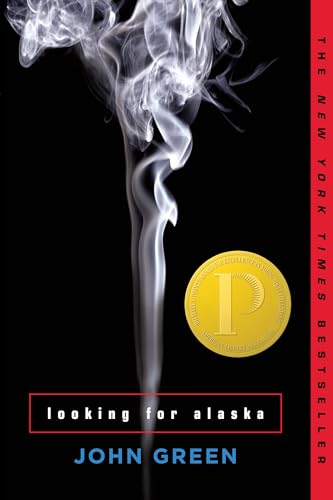Hey there, fellow bookworms! Ready for an emotional rollercoaster? You’re in luck! I’m reviewing John Green’s “Looking for Alaska.” Grab your tissues, because we’re about to explore character development, themes of love and loss, writing style, and the overall impact. Will it tug at your heartstrings or leave you scratching your head? Let’s find out!
In a nutshell
Looking for Alaska by John Green is a young adult novel that falls under the coming-of-age genre. It takes readers on an emotional journey through the eyes of Miles ‘Pudge’ Halter, who attends a boarding school in Alabama. Here, he meets the enigmatic Alaska Young, and their budding friendship explores themes of love, loss, and the quest for meaning. With memorable characters and a gripping narrative, this story navigates the complexities of adolescence, making it a cherished read for many. But be warned: you’ll want to keep some tissues handy as you flip the pages!
Exploring the Complex Characters in ‘Looking for Alaska’
The character development in John Green’s ‘Looking for Alaska’ feels like a rollercoaster ride, only with fewer safety measures and more emotional dips. Ever felt like a third wheel at a party? That’s me with Miles, also known as Pudge, a seemingly aimless teenager. You can’t help but root for him as he moves from his mundane life to the unpredictable world at Culver Creek boarding school. Meeting Alaska Young, the novel’s enigmatic gem, is like bumping into your lifelong crush at a garage sale; totally unexpected and confusing in the best way.
The character dynamics in ‘Looking for Alaska’ are like a well-cooked stew; flavors blend, some clash, but nothing beats the taste. The book serves a hot dish of friendship, longing, and heartbreak. Takumi and Colonel, the other key figures, add spice to this mix, transforming the narrative into a complex concoction. Pudge and Alaska’s chemistry is complex, like trying to solve a Rubik’s cube while blindfolded; you know you might not get it right, but it’s still fun to try.
Sometimes, the friendships seem more real than the ones I’ve had with my childhood pals. However, the character depth does waver at times, leaving a pothole or two in an otherwise smooth road. Just like my attempt to be a gourmet chef—ambitious but with occasional burnt edges.
The next section will tantalize your literary taste buds with themes of love and loss, as ‘Looking for Alaska’ is a buffet of raw emotions.
Themes of Love and Loss in ‘Looking for Alaska’
In John Green’s masterpiece ‘Looking for Alaska,’ love and loss dance together like a tango of emotions. You get filled with the beauty and heartache of first love. Remember your own teenage years? I sure do. Felt like a Hollywood romance back then, but without the budget or the script. Just like the characters, Miles ‘Pudge’ Halter finds himself living through love’s highs and lows, courtesy of the enigmatic Alaska Young. Their connection offers a deep dive, oops, a genuine exploration of affection and heartbreak that many of us can relate to.
The rollercoaster of feelings reaches its peak when the book explores loss. You know when you lose something, and it feels like your world just fell apart? Green captures this emotional upheaval as Pudge struggles to cope with Alaska’s sudden death. This loss not only affects him but ripples through their circle of friends, leaving a mark on each one of them. Love and loss are intertwined, demonstrating how they shape lives and steer us into uncharted waters. ‘Looking for Alaska’ shows readers the impermanence and beauty of these relationships, reminding us of the impact people have on our lives, even if they’re gone too soon.
These themes resonate deeply, moving readers to ponder life’s fleeting moments. As we transition, let’s chat about the book’s writing style and narrative flow, where prose glides like a smooth jazz tune on a summer evening.
Writing Style and Narrative Flow in ‘Looking for Alaska’
Let me tell you, John Green has a way with words that makes you feel like you’re right there with the characters. In ‘Looking for Alaska’, the writing style is effortless and keeps you engaged from the first page to the last. Green cleverly divides the book into ‘Before’ and ‘After’ sections, creating a sense of anticipation and intrigue. You’re continuously wondering, “What’s going to happen?” The narrative flow is smooth, transitioning between moments of humor and heartache without feeling jarring.
One of the things that stood out to me was the use of first-person narrative. Miles, or ‘Pudge’, is the story’s anchor, and his voice is authentic and relatable. Green’s use of short, punchy sentences made me feel like I was listening to a friend recount a wild adventure, rather than reading a structured novel. There’s something refreshing about this style — it’s like wearing a comfy pair of shoes, just right for a journey.
However, sometimes the metaphoric language feels a bit heavy-handed. I found myself saying, “Alright, we get it. It’s deep,” a couple of times. But hey, isn’t that part of the charm? Green’s style might not be everyone’s cup of tea, but it’s hard to deny the emotional connection he fosters with readers. It’s the kind of book that makes you think long after you’ve put it down.
In the next section, I’ll explore the overall impact of ‘Looking for Alaska’ and the emotions it stirs in readers. Spoiler: it might just tug on your heartstrings like a pro harpist playing your favorite tune.
Overall Impact and Reader’s Emotions in Looking for Alaska
“Looking for Alaska” sent me on an emotional rollercoaster, the kind that makes you want to throw your hands in the air and scream, “More!” I say this because when I read it, I was transported back to my high school days—a time full of awkward crushes, overwhelming dreams, and a sense of belonging I felt only on the last day of math class.
John Green crafted a world that lingers in the hearts of readers long after they’ve turned the last page. The emotional intensity in ‘Looking for Alaska’ isn’t just a tidal wave; it’s a tsunami that leaves a mark. When I first closed the book, I sat there processing my feelings like a deer caught in headlights. Thank heavens I wasn’t actually on the road!
The book manages to tackle serious themes—like mortality and the search for meaning—without losing its sense of humor. It’s like a stand-up comedian trying to deliver a TED Talk about existentialism. Although some parts felt a tad melodramatic, it’s exactly this emotional depth that clicks with readers. Whether it was the gut-punching sorrow or the warm fuzziness of budding friendship, each emotion was palpable and raw.
One thing I felt could have been better tackled was character depth towards the end. Just when I thought I figured out a character, the book threw a curveball that left me a bit befuddled. But hey, life is full of surprises, right?
In short, “Looking for Alaska” is a must-read if you want a story that’s both heart-wrenching and heartwarming. Just keep a box of tissues nearby. Trust me; your heart won’t regret it.
Conclusion
Well folks, that’s a wrap on my review of ‘Looking for Alaska’. John Green’s tale swirls with emotional depth, exploring love and loss with the grace of a hippo on roller skates—awkward yet somehow captivating. Expect a heartfelt narrative packed with rich character development, though some metaphors can feel heavy-handed. Despite slight melodramatic turns, its impact and relatability make it a must-read for those who fancy emotional tales. Keep tissues ready! The book may not be perfect, but it leaves a mark, much like that time I tried to juggle flaming torches—risky, thrilling, and a memorable experience!


